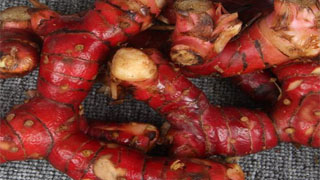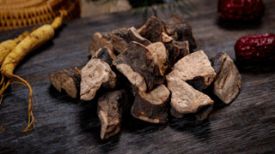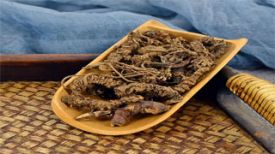
1. Aliases
Heshan Jiang, Jiujiang Lian, Ginger Leaf Epimedium, Jiulong Pan, Ginger Qi, Gao Liang Jiang, Chicken Claw Lotus2. Plant morphology
Perennial herbaceous plant, with a height of 35-70 centimeters. Roots and stems are transverse and branched. Leaves are usually 2-5 pieces; Near sessile to with petioles up to 2 centimeters long; Tongue 2-lobed, approximately 2 millimeters long, covered with short pubescence; The leaves are lanceolate, oblanceolate or narrow elliptical in shape, 25-40 cm long and 4-7 cm wide, gradually pointed at both ends, with a small pointed tip at the tip, and covered with short pubescence on both sides. The raceme is terminal, 15-30 centimeters long, and the inflorescence axis is densely covered with villi; Flowers usually consist of two clusters, with small flower stems about 2 millimeters long; Calyx rod-shaped, 1-1.2 cm long, covered with short pubescence, apex 3-toothed; The corolla tube is about 1 centimeter long, sparsely pilose, and the corolla lobes are oblong, about 1 centimeter long. The outer layer is covered with fuzz, and the posterior one is cup-shaped; Lateral degenerate stamens linear, about 5 millimeters long; Lip ovate, about 6 millimeters wide, white with red veins, apex 2-lobed, margin with irregular notches; Stamen length is 1.2 to 1 4 centimeters; The ovary is densely covered with villi. Fruit spherical or elliptical, orange red when ripe, with persistent calyx tube at the apex; The seeds are polygonal and have a camphor flavor. The flowering period is from April to August, and the fruiting period is from July to December.
3. Origin distribution
Born in damp and shady areas under the forest. Mainly produced in Zhejiang, Fujian, Jiangxi, Hubei, Hunan, Guangdong, Guangxi, Sichuan, Guizhou, Taiwan and other places in China.
4. Harvesting and processing
Harvest in spring after 2-3 years of planting, remove sediment and impurities, wash and sun dry.
5. Characteristics of medicinal herbs
This product is cylindrical in shape, with branches, measuring 5-20 centimeters in length and 0.3-1.2 centimeters in diameter. The surface is brown or reddish brown, with fine longitudinal wrinkles and dense gray brown segments. It is covered with scaly leaf sheaths, and there are slender fibrous roots and circular root scars on the segments. There are stem or bud marks at the top of the branch. Flexible and not easily broken. The cross-section is yellow white or gray white, with strong fibrous properties and obvious powdery texture. The circular endothelial layer has obvious ring patterns, and small pores and muscle points can be seen. The aroma is fragrant and the taste is spicy.
6. Nature, taste, and meridian tropism
Warm in nature and spicy in taste. Return to the lung meridian and stomach meridian.
7. Effect and function
Warm, dispelling cold, dispelling wind, promoting blood circulation. Belonging to warm internal medicine.
8. Clinical applications
Internal administration: decoction, dosage 5-10 grams. Apply an appropriate amount for external use, mash or boil and wash. Used for abdominal cold pain, rheumatic muscle and bone pain, labor injury, vomiting blood, falling damage and stasis, menstrual disorders.
9. Pharmacological research
Small doses of ginger have no effect on the small intestine of guinea pigs, while high doses have an inhibitory effect. Both small doses of ginger and ginger have partial antagonistic effects on rat intestinal tension and tonic contractions caused by acetylcholine and barium chloride. Ginger decoction has varying degrees of inhibitory effect on experimental gastric ulcers in pyloric ligation, stress, and reserpine type rats by gavage, but its effect on indomethacin (indomethacin) type gastric ulcers is not significant. In vitro experiments showed that the minimum inhibitory concentration (MIC) of ginger decoction against Yersinia coli and Proteus morganii was 1/160 (with moderate antibacterial activity), the minimum bactericidal concentration (MBC) was 1/80 (with low bactericidal activity), and its inhibitory and bactericidal effects on Shigella flexneri were 1/40 and 1/10, respectively, indicating low efficacy. It did not exhibit inhibitory or bactericidal effects on enterotoxic Escherichia coli.
10. Chemical composition
Root and Stem Volatile Oils: 9 (10) - Frustulene-11 alcohol, 9-hydroxy gingerol dihydroagarwuran, 10- epi - γ - eucalyptol, 3 β, 4 β - epoxide agarwuran, gingerone, gingerol, patchouli alcohol, gingerol peroxide, isogingerol peroxide, gingerol peroxide, 6-hydroxygingerol, gingerol epoxide, gingerol, furan geranione A and B, α - agarwuran, 4 α - hydroxydihydroagarwuran, 3 α, 4 α - epoxy agarwuran, β - eucalyptol, gingerol, 6,9-guaiaceae, 10-epi-5 β - hydroperoxy - β - eucalyptol, 10-epi-5 α - hydroperoxy - β - eucalyptol, 4,10-epi-5 β - hydroxydihydroeucalyptol.
11. Taboos for use
It is not yet clear.
12. Prescription
1. Treatment of rheumatic muscle and bone pain: 500g of ginger root, 30g of Sichuan pepper seed, and 150g of acanthopanax skin. Boil and wash with water. (Hunan Pharmacology)
2. Treatment of stomach pain: 3-6 grams of mountain ginger root and 3-6 grams of black medicine. At the end of the research period. Warm water delivery service. (Jiangxi Herbal Medicine)
3. Treatment for cough caused by external factors: 9g of ginger root, 9g of mulberry bark, 9g of thatch root, and 6g of perilla leaves. Boiled in water. (Hunan Pharmacology)
4. Treatment for falls and injuries: 15g of mountain ginger root, 30g of blood vine root, 15g of Qian Cao root, 9g of Niu Xi root, and 9g of Ze Lan root. 500g Baijiu, 3-7g dipping. Take 15-30 grams per serving. (Jiangxi Herbal Medicine)
5. Treatment for weak cough: ① 9g of Jiujiang Lian and 9g of Da Geese Intestine. Stew meat to eat. ② 30g of Jiujianglian powder and 30g of walnut kernels. Add 60g of bee sugar, mix well and steam until cooked to make longan sized balls. Inclusive swallowing. (Guiyang Folk Herbs)
The content of the article is for clinical reference only. Non professionals in traditional Chinese medicine are not allowed to try medication.


